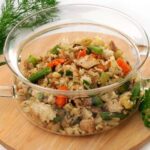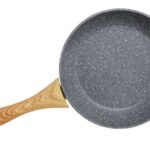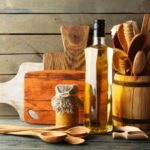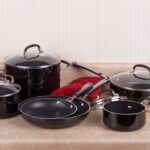What Is a Glass Top Stove?
Glass ovens are known for their flat and aesthetic cooking surface, which is the perfect complement to modern kitchen décor. The cooking surface is made of a mixture of glass and ceramic. The mixture is thermally treated to make it stronger and able to withstand rapid temperature changes.
Glass and ceramic stovetops have a smooth cooking surface that is very easy to keep clean. Unfortunately, this surface is delicate and can be prone to scratches. You must be careful and use appropriate cookware to avoid scratching or damaging the glass surface.

To extend the lifespan and maintain the brand-new look of your glass cooktop, you need to learn which cookware is compatible with it and which cookware pieces can potentially be harmful to your stylish yet fragile appliance.
Below is a list of five types of cookware that can be potentially harmful if used to cook on ceramic stovetops.
1. Heavy Cookware Pieces Shouldn’t Be Used on Glass Top Stoves
Heavy utensils do not necessarily damage the surface of glass hobs. However, weight combined with other factors increases the likelihood of cracking. A heavy pot is more likely to fall than a light one, so its weight can potentially damage the delicate glass surface. Filling an already heavy pot with food will multiply its weight and the glass surface may break if the pot is dropped. When moving heavy pots, you should lift them instead of dragging them across the hob. To be on the safe side, avoid using overly heavy cookware when cooking on a glass stove.
Heavy cookware is typically made of cast iron, stoneware, glass, or 100% ceramic.
2. Cookware with Rough Surface
Utensils with rough bottoms can easily scratch the glass surface. This happens when you push such pieces of cookware back and forth across the glass instead of picking them up. Drugging rough cookware items across the cooktop can leave permanent scratches on the surface. Such damage typically occurs when you use stoneware and 100% ceramic cookware. You should be extremely careful when moving this cookware or avoid using rough-bottomed cookware on glass cooktops.
3. Cheap Pans with Uneven Bottom
The cookware you use on glass and ceramic stoves must have a completely flat base. If the cookware is not completely flat, it will not make full contact with the glass surface and your meal may take longer to cook. This cookware is also less energy efficient than flat-bottomed utensils.
For the same reason, avoid using old pans with curved or warped bottoms, as these make the cooking process less efficient. Your efforts to place the pan correctly may even increase the risk of damaging the glass surface.
To check the flatness of your cookware, there is a simple test. Turn the pan over and place a measuring stick flat on the bottom. Your pan will have a completely flat bottom if there is no space between the surface of the pan and the ruler. Turn the pan upside down and place a line drawing gauge flat against the bottom. Your pan has a perfectly flat bottom if there is no space between the surface area of the pan and the ruler.
4. Pans with Soiled Bottom
The cookware you use on the glass stove should be dry and clean. Food particles from the outside surface of the base can leave stains on the stove surface. Caked-on dirt can also prevent the cookware from making full contact with the burner. To keep your stovetop clean, do not place cooking utensils, hot lids, or hot bakeware on the glass surface.
5. Cookware with a Bottom Diameter that Doesn’t Match the Burner
Only use cookware with dimensions that fit the burner. The diameter of the cookware should be neither smaller nor larger than the diameter of the burner. Food will not cook evenly if the pot is larger than the burner. Also, the meal takes longer to cook and you have to stir constantly. If there is a difference in dimensions in favor of the pot, make sure it is no more than an inch. Using small pans on large burners results in wasted energy.
How Different Cookware Materials Perform on a Glass Top Stove
Will Cast Iron Damage a Glass Cooktop?
Cast iron cookware is often considered too heavy for glass stoves, so you should use it with extra caution. Use only high-quality cast iron cookware and be sure to place it carefully on the burner. Never drag the pan across the surface if you want to move it.
Clean your cast iron pan regularly to prevent dirt from building up on the glass. Be careful not to leave excess oil on the outside of the pan as it can burn on the stove. Pay particular attention to the area of the pan that is in direct contact with the glass surface.
Enameled cast iron is a better option than bare cast iron cookware because the enamel coating makes the surface smoother and less prone to scratches. However, like regular cast iron, an enameled cast iron pan can be quite heavy. Therefore, be careful not to pull it and place it carefully on the burner.
Can You Use a Carbon Steel Pan on Glass Top Stove?
Carbon steel pans are much lighter, so their weight is not an issue for glass cooktops. However, make sure that the pan has a clean, flat, and smooth bottom. Old carbon steel pans may attract rust or have a warped bottom.
Unlike regular pans, carbon steel woks have a round or small flat base designed for use on gas or electric stoves. When used on a glass top stove, the bottom has little direct contact with the burner and although it gets very hot, the heat is not well distributed around the edges. In addition, moving the wok increases the risk of scratching the glass surface.
Is It Safe to Use Ceramic Cookware on Glass Cooktop?
Cookware made from 100% ceramic usually has a rough base, which is not ideal for a glass stove. Untreated ceramic bases can leave tiny scratches on the glass. In addition, ceramic pots are heavy, which also makes them unsuitable for cooking on a glass stovetop.
Stoneware pans can also cause scratches. Therefore, you need to be extra careful when using this type of cookware on your glass cooktop.
What Is the Best Cookware for Glass Top Stoves?
Stainless steel cookware has optimal weight and a smooth surface that does not scratch the glass. Stainless steel cookware is stylish and complements the modern design of the glass cooktop. The only downside is that stainless steel is not a good conductor of heat.
Enameled stainless steel is also a great option for glass-ceramic stoves. Enameled stainless steel is not as heavy as enameled cast iron making it perfect for a glass cooking surface.
Anodized aluminum cookware is an excellent choice for glass stoves. In addition to the excellent thermal conductivity, this cookware is gentle on the sensitive glass surface. The good heat conduction and the flat bottom design make the cooking process very energy efficient.
Nonstick cookware with a ceramic coating is another good option for glass stoves. Ceramic cookware with an aluminum core distributes heat well, ensuring quick and energy-efficient cooking. In addition, this type of cookware prevents food from sticking and is very easy to clean.



